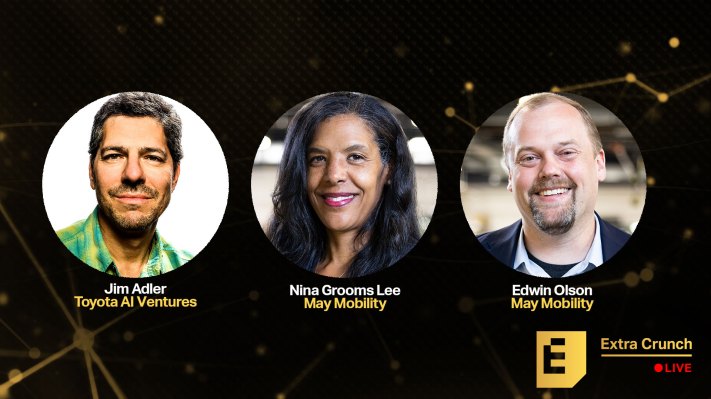When a founder has a work history that includes the name of the parent company of one of their key investors, you probably assume that was one of the first deals to come together. Not so with May Mobility and Toyota AI Ventures, which connected for the company’s second seed round, after May went out and raised its original seed purely on the strength of its own ideas and proposed solutions.
That’s one of the many interesting things we learned from speaking to May Mobility co-founder and CEO Edwin Olson, as well as Chief Product Officer Nina Grooms Lee and Toyota AI Ventures founding partner Jim Adler on an episode of Extra Crunch Live.
Extra Crunch Live goes down every Wednesday at 3 p.m. EDT/noon PDT. Our next episode is with Sequoia’s Shaun Maguire and Vise’s Samir Vasavada, and you can check out the upcoming schedule right here.
Meanwhile, read on for highlights from our chat with Olson, Grooms Lee and Adler, and then stay tuned at the end for a recording of the full session, including our live pitch-off.
A different approach to corporate VC
One thing Adler brought up early in the chat is that Toyota AI Ventures likely takes a different approach than most traditional corporate VCs, which are often thought of as being more incentivized by strategic alignment than by venture-scale returns. Adler says the firm he founded within the automaker’s corporate umbrella actually does behave much more like a traditional VC in some ways than many would assume.
”At Toyota AI Ventures, we focus on financial return before strategic return,” he said. “Which is often the opposite of most corporate VCs, which tend to say ‘Well, if you’re not going to be financially successful, then we’ll be strategically aligned.’ I think that is actually exactly the opposite, because then you’ll have really well-aligned weak partners that are often unreliable, which doesn’t deliver any strategic return at all. And so we focus on financial return first, because that’s the only way that you really understand whether a company will actually change the marketplace.”
Adler said that at first blush, Olson and his concept for May Mobility seemed like the makings of a financially successful business with strong fundamentals, but he also wanted to avoid making a common type of mistake that can often occur between smart, well-meaning people who work for the same entity.
“We were really familiar with Ed, we knew him well, I admired [May] and thought the world of them,” said Adler. “But there’s this exposure bias that kind of creeps in. And the great thing about venture capital is it’s a collaborative asset class. So we have this rule that we always want companies that we know, or founders that we know really well, to raise their first slug of money with a lead VC that is not us, or to not participate in the first investment at all.”
Lean startup principles applied to big challenges
Nina Grooms Lee talked about what attracted her to May as a longtime automaker veteran and leader of autonomy projects at Ford. The seasoned executive said that it was first and foremost about May’s willingness to tackle a hugely challenging technical problem with a sensible approach that adhered to lean startup principles.
“One of the key things that really stood out to me when I first started learning about them was the fact that they were all about putting product into market early,” she said. “This goes right back to Lean Startup basics: Get it out there, in an MVP type of fashion; don’t try to make it perfect, just make it good enough, so that you can quickly learn and start to increase that flywheel of feedback from the market that you can feed into your product development and your innovation process.”
Grooms Lee described herself as a “product junkie,” which is what made that feedback loop that included actual use data particularly attractive. She also cited the clarity of purpose and mission and the culture that Olson and his team created at May as key factors in her decision to take on the role.
Taking a risk, and validating the approach
“Starting a company is scary,” Olson said. “I stepped out of something that was … more comfortable is not quite the right word, but exciting. The work I was doing at TRI [Toyota Research Insititute] was great, and so you’re kind of taking a step into the unknown, and as a first-time CEO, as well, so that’s scary.”
Despite the apprehension, or perhaps because of it, Olson said he wanted to ensure that what he built with May was a viable business and a workable solution to autonomous mobility.
“It was actually really important to me to make sure that I wasn’t fooling myself, so it wasn’t just Jim saying ‘No, we’re not going to fund you the first time,'” he said. “In fact, I didn’t ask him. We talked a lot about the startup, and I got a lot of great advice from Jim, but when it actually came time to pass the hat around, I didn’t offer it. It was really important to me to get that external validation from people, so I just had to go and pound pavement and pitch and convince them on the fundamentals of the business and the go-to-market plan. It took a long time, but getting that filled me with so much more confidence about what we were doing that it made sense to take that approach.”
Olson, Adler and Grooms Lee offer their feedback on three live pitches from startups selected from the Extra Crunch Live audience during the last 30 minutes of the episode below.
